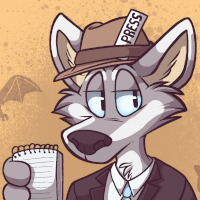reWritten, by Jako Malan – Book Review by Fred Patten
by Pup Matthias
Submitted by Fred Patten, Furry’s favorite historian and reviewer.
 reWritten, by Jako Malan
reWritten, by Jako Malan
Plainfield, CT, Goal Publications, April 2017, trade paperback $15.00 (200 [+2] pages).
The setting of reWritten is a world from which humans have disappeared and been replaced with anthropomorphized Mammalœ.
It’s best not to dwell on the confusing background. The Mammalœ are aware of man’s past existence:
“We are, indeed, not the first to call this world our home. Bright-eyed and naive, our earliest ancestors wandered forth as the sun set on the age of man and rose for Mammalœ. The ruins of their magnificent civilization would be both the foundation and inspiration for our own.” (p. 1)
What happened to man? It doesn’t sound like man became extinct through war, unless it was a war that didn’t include blast damage – the Mammalœ consider man’s ruins to be “magnificent”. Have the Mammalœ (the narrator is an anthro jackal; others are aardvarks, meerkats, springboks, rats, rabbits, mongooses, servals, cheetahs, etc.) evolved to replace man? That would take millions of years. Surely there wouldn’t be anything of man’s left to seem “magnificent”. The Mammalœ civilization seems like a rundown funny-animal imitation of man’s; a smoky city that includes coal power, rickety electric trams, hand-cranked automobiles for the rich; most Mammalœ riding bicycles… The Mammalœ such as the rat and zebra are all the same size, presumably human. It’s easier to just accept that man was here but is gone now, and anthro mammals (Malan is South African; so is the setting – the Mammalœ currency is even rands, not dollars) have replaced him in early-20th-century-style cities.
Professor M. (for Makwassie) van Elsburg (a jackal), head of the Department of Anthropology and History at Mammalaœ University in Bridgend (apparently a major Mammalœ city), is approached at a reception by rich Mr. Oberholzer (a hyrax), the patriarch of the Bridgend Energy Cartel. Prof. van Elsburg recognizes him as one of the most influential and notorious mobsters in Bridgend. (He flaunts it; what’s the point of being influential and notorious if everyone doesn’t know it?) Oberholzer is also interested in the history and disappearance of man, and he has a private museum in his mansion. Five months earlier he and an associate had organized an expedition to the ruins of a human city that they hoped would provide more information. The expedition disappeared; simultaneously Oberholzer’s private collection was burglarized, and his servants began being followed. Oberholzer wants Prof. van Elsburg to lead a second expedition to the ruins, to find the hoped-for information and any clues to the vanished first expedition. Elsburg objects that he’s late-middle-aged and sedentary, without any experience in exploring, but Oberholzer’s request is similar to Don Vito Corleone’s offer that can’t be refused.
“‘Take the train to the Ashton precinct.’ Mr. Oberholzer’s last instructions interrupted my train of thought. ‘That is as far as the railways will take you. In town, I will arrange for my associate to meet you. He will brief you from there onwards. I have already contacted him with the particulars of the assignment. Be vigilant, Professor. Don’t discuss your task with anyone. And don’t disappoint me.’” (pgs. 31-32)


 Hot Dish. Volume 2, edited by Dark End. Illustrated.
Hot Dish. Volume 2, edited by Dark End. Illustrated. Furry Fandom, by Wikipedians. Illustrated.
Furry Fandom, by Wikipedians. Illustrated. De Cape et de Crocs. Acte 12, Si Ce N’Est Toi…, by Alain Ayroles & Jean-Luc Masbou.
De Cape et de Crocs. Acte 12, Si Ce N’Est Toi…, by Alain Ayroles & Jean-Luc Masbou. MoonDust: Falling From Grace, by Ton Inktail
MoonDust: Falling From Grace, by Ton Inktail Murrin Road, by L. B. Kitty
Murrin Road, by L. B. Kitty Plowed, edited by Andres Cyanni Halden.
Plowed, edited by Andres Cyanni Halden. The Art of Cars 3. Foreword by John Lasseter. Preface by Brian Fee.
The Art of Cars 3. Foreword by John Lasseter. Preface by Brian Fee. Léonid. T. 2, La Horde, by Frédéric Brrémaud & Stefano Turconi.
Léonid. T. 2, La Horde, by Frédéric Brrémaud & Stefano Turconi. Monkey Wars, by Richard Kurti
Monkey Wars, by Richard Kurti